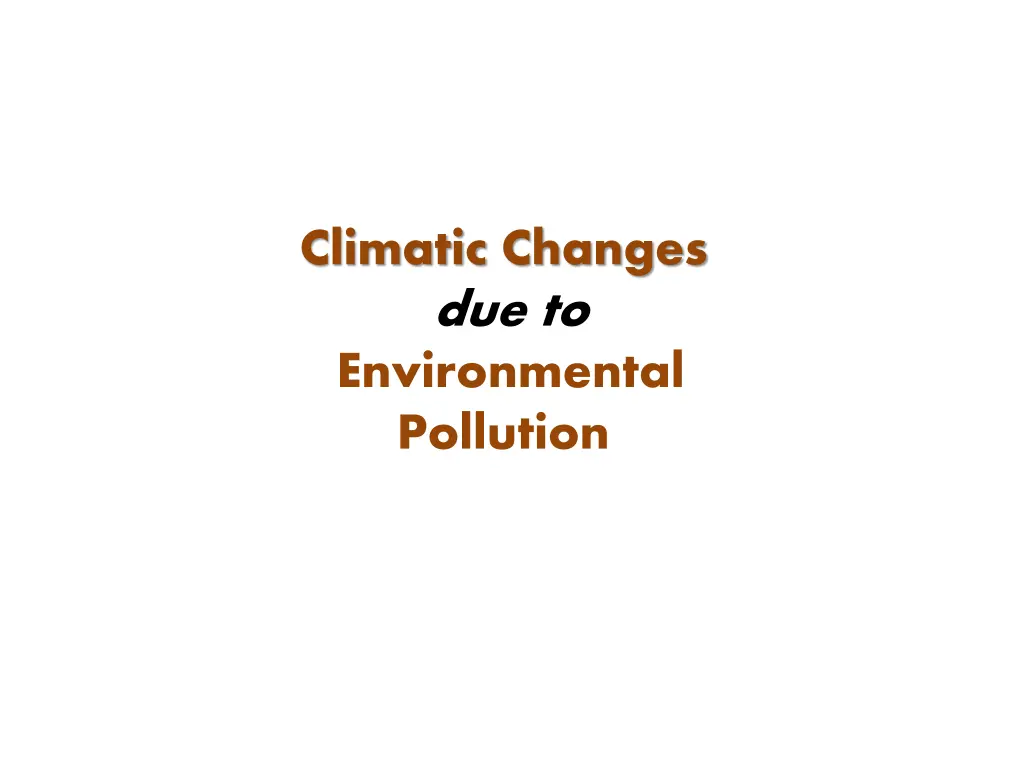
Understanding the Impact of Environmental Pollution on Climate Change
Discover the association between environmental pollution and climatic changes, including definitions of pollution, types of pollution, major air pollutants, and the role of CO and greenhouse gas emissions. Learn about the harmful substances contaminating the environment and their effects on climate, with insights on how pollution contributes to global warming and biodiversity loss.
Download Presentation

Please find below an Image/Link to download the presentation.
The content on the website is provided AS IS for your information and personal use only. It may not be sold, licensed, or shared on other websites without obtaining consent from the author. If you encounter any issues during the download, it is possible that the publisher has removed the file from their server.
You are allowed to download the files provided on this website for personal or commercial use, subject to the condition that they are used lawfully. All files are the property of their respective owners.
The content on the website is provided AS IS for your information and personal use only. It may not be sold, licensed, or shared on other websites without obtaining consent from the author.
E N D
Presentation Transcript
Climatic Changes due to Environmental Pollution
Definition of Pollution When Harmful Substances Contaminate the environment it is Called Pollution. It can be defined as: Any undesirable change in the physical, chemical, biological characteristics of any component of the environment which can cause harm to life and property.
WHAT IS CLIMATE CHANGE? Weather reflects short term conditions of the atmosphere, it can change from minute-to-minute, hour-to-hour, day-to-day and season-to-season. Climate is the average of weather over time and space. Unlike weather, which means temperature, rainfall, humidity of a particular time at a local area, climate has spatial and temporal components. It consists of many kinds of weather events, their periodicities, intensities, and nature of dynamism. When we talk about climate change, we actually understand more than the literal changes of weather events over the time and space of that climate. The scientific evidence is now overwhelming: climate change presents very serious global risks, and it demands an urgent global response. Stern Review, 2006
Types of Pollution Pollution Air Water Marine Thermal Soil Noise Nuclear
Association between Environmental Pollution and Climate Change Type Pollution Change Air Green House Gas Global Warming Air/water Thermal Pollution Global Warming water Co2 level rise Global warming water Oxygen reduce Biodiversity loss Land Solid waste Land Soil moisture loss
Major Air Pollutants Air pollutants may be particulate or gaseous. On the basis of origin they are divided as Primary pollutants ---- Are emitted directly from the point source. e.g. : PM, CO2, CO, NO2, SO2 Secondary pollutants ---- formed by interaction of primary pollutants e.g. : PAN, Smog, Ozone etc
Role of CO and Greenhouse Gas Emissions on climate change The Intergovernmental Panel on Climate Change (IPCC) states clearly in its most recent assessment report (AR5)4: Anthropogenic emissions have increased since the pre-industrial era, driven largely by economic and population growth, and are now higher than ever. This has led to concentrations of carbon dioxide, methane and nitrous oxide that are unprecedented in at least the last 800,000 years. together with those anthropogenic drivers, have been detected throughout the climate system and are extremely likely to have been the dominant cause of the observed warming since the mid- 20th century. greenhouse gas atmospheric Their effects, other of
A changing climate has a range of potential ecological, physical and health impacts, including extreme weather events (such as floods, droughts, storms, and heatwaves); sea-level rise; altered crop growth; and disrupted water systems. The most extensive source of analysis on the potential impacts of climatic change can be found in the 5th Intergovernmental Panel on Climate Change (IPCC) report.5
Regional climate effects of aerosols Present GCMs indicate that aerosols (may) influence local climate Sulfates: Cooling effect Changes in precipitation observed in China related to increase in China s SO2? Did European SO2 affect precipitation in Africa (Sahel)? Black carbon: Warming effect Issue for bio-fuels Organic carbon: Cooling effect Net effect of PM from different sources?
B. Water Pollution and Climate Change Water pollution and ocean water Property Change Changes in water temperature, Ocean acidification : Our oceans are absorbing carbon dioxide, rapidly causing them to become more acidic. This is threatening the habitat of every species Deoxygenation: Ocean deoxygenation is the reduction of the oxygen content of the oceans due to human activities as a consequence of anthropogenic emissions of carbon dioxide and eutrophication driven excess production. leading to changes in climatic property Oceanic circulation and chemistry, Rising sea levels, increased storm intensity, changes in the diversity and abundance of marine species.
C. Land Pollution and Climate Change This emerges from a natural circulation, in turn, land pollution leads to the deforestation, it leads to less rain, eventually to problems such as the greenhouse effect and global warming/climate change.
